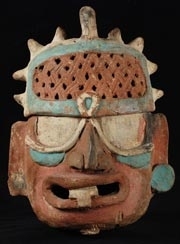Ancient Maya Pottery Comes to the College

“Painted Metaphors: Pottery and Politics of the Ancient Maya”
September 16–December 11, 2011
For immediate release: 8/9/11
For further information contact: Douglas Perkins, Administrative Operations Manager, (802) 443-5235 or deperkin@middlebury.edu
Middlebury, VT—A world-renowned collection of ancient Maya painted pottery, excavated by the University of Pennsylvania Museum nearly a century ago and reinterpreted in light of recent research in the field, provides the centerpiece for Painted Metaphors: Pottery and Politics of the Ancient Maya, which opens September 16 at the Middlebury College Museum of Art and runs through December 11.
Like so many pieces of the famous Chama pottery that conservators meticulously put back together at the Penn Museum, Painted Metaphors yields new clues to understanding everyday life—and changing politics—of the ancient Maya of Guatemala 1,300 years ago.
At the center of Painted Metaphors are almost two dozen recently conserved Maya painted vessels from Chama, a Maya village in the highlands far from the more sophisticated lowland centers of Maya culture. It was here that Penn Museum archaeologist Robert Burkitt discovered this brilliantly painted pottery, unlike anything else the region had ever produced. Why were these ceramic cylinders, painted with elaborate scenes, made in this out of the way spot? Exhibition Curator Elin Danien, Research Associate at the Penn Museum, provides a provocative explanation: these are Painted Metaphors, or pictorial narratives, reflecting the sudden introduction of people and ideas from the lowlands of the Maya world.
The exhibition, which is organized and circulated by the University of Pennsylvania Museum, includes a rare focus on the ordinary Maya, with material that reflects the ancient way of life— more than 150 ancient artifacts, including figurines, jade carvings, musical instruments, weaving implements, burial urns, cave offerings, and more. Additionally, the exhibition features photos and video of Maya life in the village of Chama today.
Maya civilization is one of the great ancient civilizations of the world. At its height, it was a densely populated, culturally dynamic society, with cities throughout the region that is now Mexico, Belize, Guatemala, and Honduras. Renowned for their once enigmatic written language (the most fully developed known written language of the pre-Columbian Americas), the Maya developed complex art and architecture, as well as mathematical and astronomical systems. Maya civilization began in the Preclassic period (circa 1500 BCE), reached its height during the Classic period (circa 250 to 900 CE, at the time the Chama pots were created), and continued throughout the Postclassic period, until the arrival of the Spanish in Yucatan in 1512. After the arrival of the Spanish, Maya civilization collapsed, though Maya culture continued and its traditions are practiced today by more than four million descendants in Mexico and Guatemala.
Though much has been learned in the last 100 years, much remains a mystery. The history of the ancient Maya continues to be reconstructed, piece by piece, not only by archaeologists in the field, but also by laboratory scientists, epigraphers deciphering ancient inscriptions, and researchers delving into the Museum collections and archives. Through field notes and records, behind-the-scenes conservation video, and more, Painted Metaphors offers a window into the process of reconstruction, and discovery, of the ancient past.
The Museum will sponsor several events related to Painted Metaphors, including an introduction to the exhibit by curator Elin Danien from the University of Pennsylvania; an illustrated lecture by Stephen Houston, Brown University, titled “Into Death’s Dark Night: Exploring a Royal Maya Tomb at El Diablo, Guatemala”; and an illustrated lecture by Middlebury’s own James Fitzsimmons titled “Rethinking Power and Authority in the Classic Maya Lowlands.”
School programs will also be offered in conjunction with the exhibit, including a teacher workshop for teachers in grades 3 through 12 on Thursday, September 29, 3–5:30 p.m.
The Middlebury College Museum of Art, located in the Mahaney Center for the Arts on Rte. 30 on the southern edge of campus, is free and open to the public Tues. through Fri. from 10 a.m. to 5 p.m., and Sat. and Sun. from noon to 5 p.m. It is closed Mondays. The Museum is physically accessible. Parking is available in the Center for the Arts parking lot. For further information, please call (802) 443–5007 or TTY (802) 443–3155, or visit the Museum’s website at museum.middlebury.edu.
